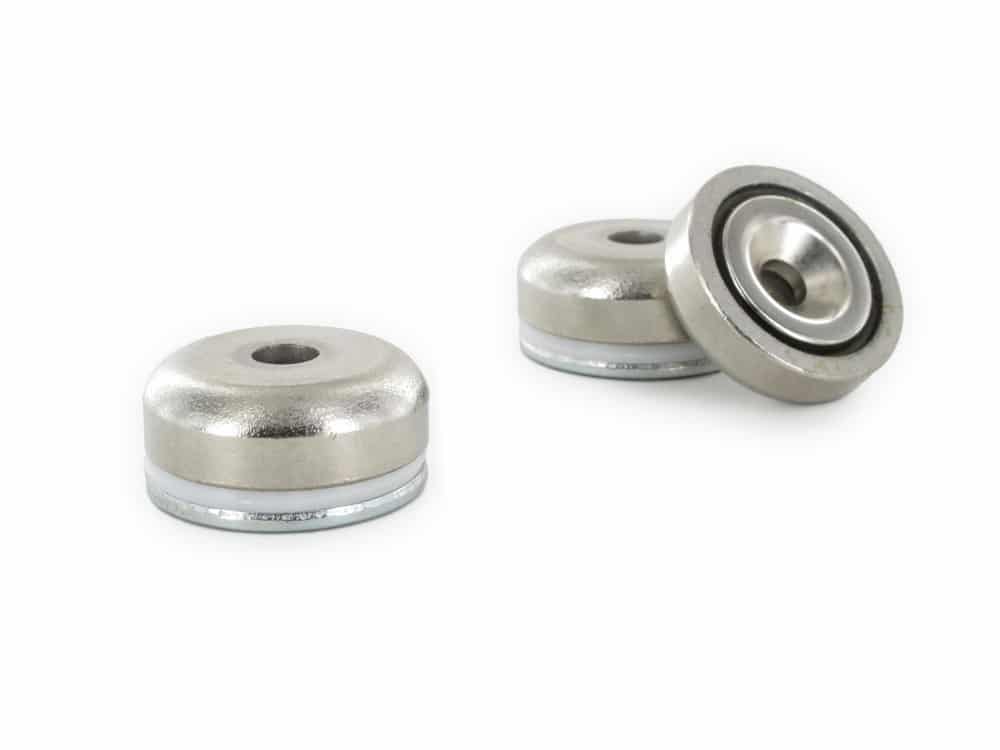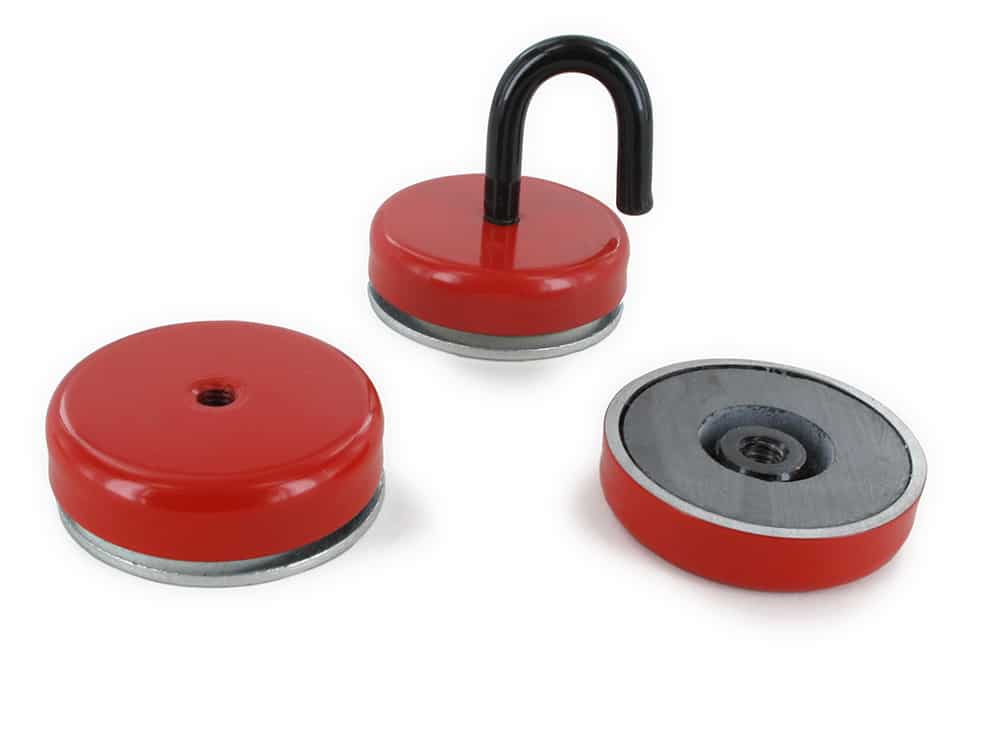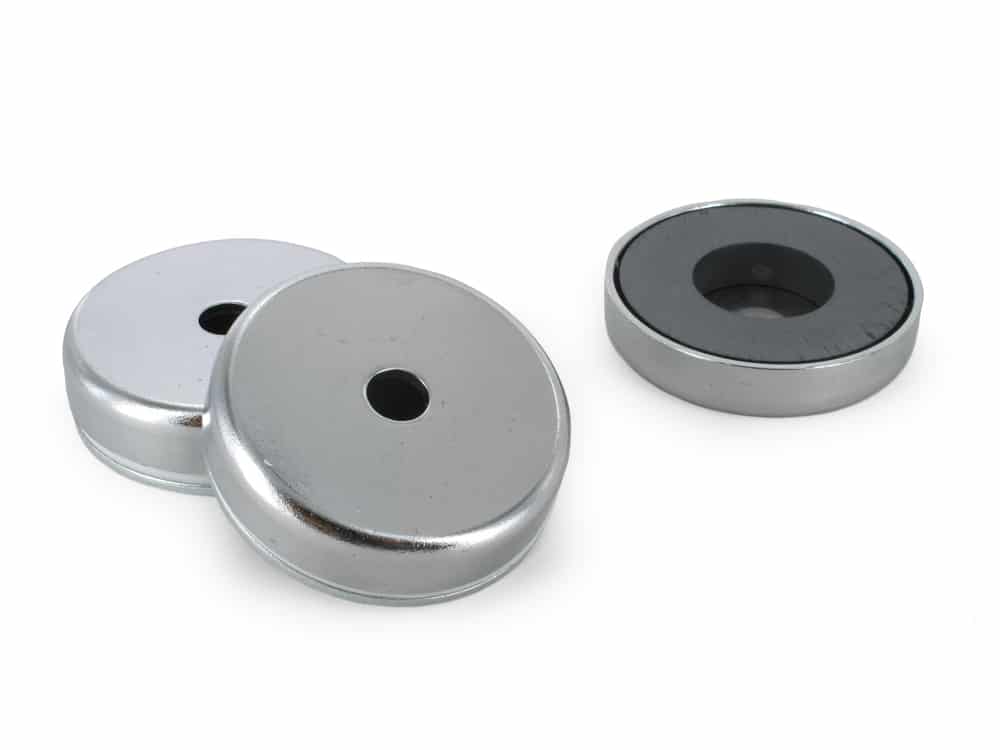New Pot Magnet Selection Guide
By Paul Fears | 15 June 2021
‘Pot Magnets’ are magnets housed inside a steel shell that protects the magnet against corrosion resistance and increases robustness. Pot Magnet applications are both wide and varied and Bunting’s new simplified product selection guide assesses different application and design criteria to select the optimum Pot Magnet.
The Selection Process
When considering the optimum Pot Magnet for an application, there are a number features to consider. These include the fixing or mounting of the Pot Magnet, the magnetic strength and performance, the finish or coating (especially for corrosive applications), and the dimensions (diameter and depth)
Selecting the Mounting or Fixing Type
This assesses the method of securing the Pot Magnet.

- Countersunk Mounting (includes Shallow Pot Magnets) – Pot magnets with a countersunk hole in the front (magnetic) face allow a simple countersunk screw to pass all the way through the magnet. This gives a flush finish on the face of the magnet with the threaded part of the fixing available of the other side of the magnet for fixing;
- Through Hole Mounting – These pot magnets utilise a ring magnet to create a space for the head of the fixing to sit clear from the magnet, allowing the fixing to pass straight through the magnet from the magnet face side. This gives a flush finish on the face of the magnet with the threaded part of the fixing available of the other side of the magnet for fixing,
- Threaded Through Hole (Includes Limpet Pot Magnets) – Such pot magnets consist of a steel disc with a ring milled out for the insertion of a ring magnet plus a tapped through-hole to allow the fixing to be threaded through the magnet. The through-hole allows the fixing to be turned past the magnet face to prize the magnet away from the structure against which it is magnetically held;
- Internal Threaded Mounting (Includes Deep Pot Magnets) – Pot magnets with a threaded hole in the top of the pot allow the attachment of a fastener. This enables more magnetic material to be housed within the pot therefore increasing performance;
- Internal Threaded Stud – Internally threaded stud or boss enable the attachment of a fastener to the pot magnet. As the stud or boss forms part of the outer section of the Pot it allows more space for a larger magnet in the pot therefore increasing magnetic performance;
- External Threaded Stud – These pot magnets feature a threaded stud or boss, which is perfectly suited for screwing the pot magnet into existing tapped holes. Other threaded attachments can be screwed directly onto these pot magnets. As the stud or boss forms part of the outer section of the Pot it allows more space for a larger magnet in the pot therefore increasing magnetic performance;
Selecting the Magnet Material
There are four (4) different types of magnet material used in Pot Magnets, each producing a different performance in accordance with a specific application:

- Ferrite (Fe) Magnets – Producing a deep and strong magnetic force, with benefits including corrosion resistance, a long lifecycle, the ability to operate up to 250°C, and a low cost;
- Neodymium (NeFeB) Magnets – These high-strength Rare Earth magnets produce the highest performance. Neodymium Pot Magnets operate up to 80°C, but will corrode if the plating is damage;
- Samarium Cobalt (SmCo) Magnets – This type of Rare Earth magnet out performs Neodymium at higher temperatures and operates at temperatures up to 250°C. SmCo also has an excellent resistance to corrosion;
- AlNiCo Magnets – This magnet is stronger than Ferrite with an excellent resistance to corrosion. AlNiCo produces the strongest magnetic field of any magnet when exposed to extreme temperatures up to 450°C;
The Finish or Coating of the Pot Magnet
There is a wide range of coatings or casing specifications including:

- Chrome Plating – This provides excellent protection against corrosion;
- Nickel Plating – Also provides protection against corrosion;
- Stainless Steel – Highest level of corrosion resistance – perfect for marine applications;
- Painted – Historically, Alnico Magnets are painted Red. This offers slightly enhanced protection to surface corrosion, but is mainly aesthetic;
- Rubber Coated – Offers much better shear (sliding) resistance. Rubber coating also offers greater protection to the surface you are fixing the magnet to i.e. painted surfaces or highly polished surfaces;
The Size and Depth of the Pot Magnet
It is important to consider both the Diameter and Depth of the Pot Magnet to ensure optimum performance for a given application. Generally, the greater the size of the magnet the greater the performance. However, Pot Magnets using Neodymium offer greater performance so a smaller Neodymium magnet can easily outperform a much larger magnet made from another magnetic material.
The Pull Force of the Pot Magnet
Each Pot Magnet within the range has a stated ‘Pull Force’ displayed in kilogrammes (kgs) which relates to the performance in a direct pull test. This allows easy comparison between various Pot Magnets. The ‘Pull Force’ of a magnet will be reduced when there is an air gap between the face of the magnet and the attracted magnetic surface such as paint, corrosion, and uneven surfaces. The smoother the surface, the better the pot magnet performance.
Hooks or Eye Bolts
The design of a Pot Magnet is ideal for use with hooks and eye bolts. A wide range of suitable hooks and eye bolts are available in a number of thread sizes for any appropriate Pot Magnets.
Pot Magnet Applications
The range of Pot Magnets suits a diverse variety of fixing and fastening applications including:
- Marine;
- Point of Sale;
- Window dressing;
- Door, cupboard and gate clamps;
- False ceiling clamps;
- Signs and banners;
- Torque limited seals;
- Jigs and fixtures;
- Lighting fixtures and assemblies;
- Marketing and exhibition displays;
- Retrieval magnets;
- Industrial fixings;
Related Technical Article
Magnet and Magnet Assembly Design
Bunting designs and manufactures a wide range of magnet setters, magnetisers, magnets and magnetic assemblies. Many are bespoke for specific applications. For further information on any of the products mentioned in this article, or for bespoke magnet assemblies and magnet designs, please contact us via:
Phone: +44 (0) 1442 875081
Email: sales.berkhamsted@buntingmagnetics.com
Via Bunting-eMagnets for online purchase of Magnets and Magnetic Technology
Follow us for all our latest news on Social Media



